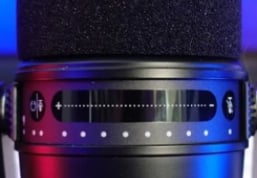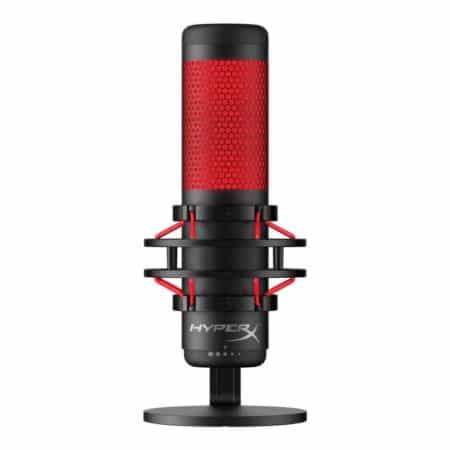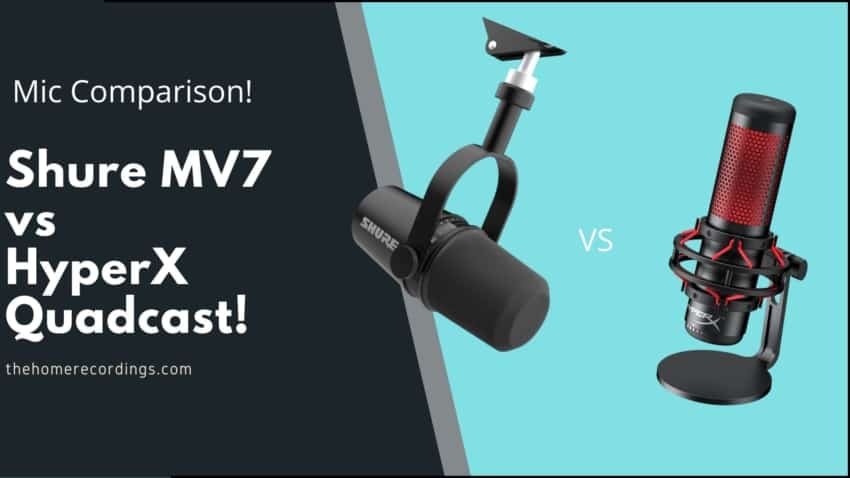Last updated on December 29th, 2023 at 09:54 pm
The HyperX Quadcast has been around for some time now, and many streamers & gamers have been using it ever since. However, is the more modern Shure MV7 better, and will it suit your needs best?
In this article, I will go over the differences between these two microphones, their strengths as well as their weaknesses, how they sound, if they come with any distinctive features, the included software, and more.
In short, here are the differences between the Shure MV7 and the HyperX Quadcast: The Shure MV7 is a dynamic microphone with USB and XLR connectivity that has a very balanced audio signal and a very present but clear low end, whereas the HyperX Quadcast is a condenser mic that offers four different polar patters (Cardioid, Omni, Bi-directional, Stereo) with a worse sound overall.
So, let’s get this going shall we? Starting with the Shure!
Shure MV7 Overview

The Shure MV7 is a relatively new mic that seems to have been designed to bridge the gap between the more affordable USB microphones and the almighty SM7B, which is the standard podcasting mic that sells for roughly $400.
The Shure MV7 looks very similar to the SM7B and it’s also a dynamic microphone, which is not that common for USB microphones since most of them are condensers, and this means that it generally won’t pick up as much background noise, making it a good choice for anyone who is running a podcast or gaming at home where there might be some noise.
The most important feature of the Shure MV7 is that it not only features a USB connection, but an XLR one as well, and if you read any of my other USB mic-related articles then you probably know that, while I like USB mics and I think that they have their place, they don’t offer an upgrade path and you will end up spending a lot more once you move on to a more professional setup.
With the Shure you can simply buy a Mixer or an Audio Interface and won’t have to worry about not being able to use it since you can simply connect it to the mixer using an XLR cable.

Another distinctive feature is its interactive touch panel on the top which lets you control the audio level, the monitor mix, and you can tap it to mute/unmute the mic and the headphones. While I do think that this is a really modern way of doing things, I don’t know if a touch panel will last longer than knobs, so we’ll have to wait and see.
Lastly, it comes with the ShurePlus MOTIV software which comes with a lot of features that podcasters and gamers are going to enjoy, such as:

- Control the gain automatically or do it manually.
- Change the tone from Dark to Natural or Bright.
- Adjust the monitor mix.
- Adjust the audio “view” of the mic, such as “Near” and “Far”.
- Manual mode lets you adjust the gain, the monitor mix, it offers some basic EQ, a limiter, and a basic compressor.
The EQ and compressor only offer basic settings that you can turn on or off, like High-Pass filter, presence boost, etc., and don’t really give you a more granular control over the signal.
The Limiter is an excellent feature to have, especially for podcasters and gamers, since they prevent loud audio spikes, which could easily jump scare your audience.
What comes in the box?
- Shure MV7 USB/XLR Microphone.
- Micro USB to USB-C cable.
- Micro USB to USB-A cable.
Features
- USB and XLR connections.
- Touch Controls (no knobs).
- Dynamic microphone (better for background noise).
- ShurePlus MOTIV software for better control over the audio signal.
How does it sound?
This mic reminds me a lot of the way the Shure SM7B sounds, especially in the low end since it makes your voice sound deep and really full, which is why I think that it’s especially good for podcasters. Other than that, it sounds really balanced and I don’t think that there’s anything that stands out as “bad”, like no frequencies poking their head out too much.
As far as recording music goes, it actually surprised me quite a lot since recording my acoustic guitar sounded full but not boomy, and the higher end had a nice open airy sound to it. Overall, quite impressed.
One thing that I don’t particularly like, however, is the foam pop filter, especially for being such an expensive microphone, since I feel like it doesn’t really do that much in terms of reducing the plosives. It’s super thick on the sides but the top is extremely thin (hold it up against a light and you can almost see right through it).
I don’t know why they went with this design, maybe a thicker pop filter affected sound quality? I don’t know, but it doesn’t work as well as I would’ve hoped.
So, either offset it when recording (off axis) and see if you like how it sounds, or find a way to put a pop filter in front of it.
Also, it doesn’t come with a built-in shock mount, so taping on the desk, keyboard, or just accidentally bumping up against the boom arm/tripod, will transmit all of that vibration into the mic.
Specifications
- Polar Pattern; Cardioid
- Connectivity: XLR and USB
- Frequency Response: 20Hz- 20kHz
- Sample Rate: 44.1/48kHz/16/24-bit
- Max SPL: 132dB
- Weight: 550g
Get the Shure MV7 here.
- Shure MV7: Amazon, Sweetwater.
HyperX Quadcast

So, firstly, this microphone is clearly aimed towards gamers who want to stream their gameplay, or just YouTubers in general, because of the way it looks.
Of course, it can be used to do almost anything since it’s a very versatile microphone, but even though I like its appearance, it’s definitely not as professional-looking as some other microphones, including the Shure MV7, which looks way more podcast-worthy.
The HyperX Quadcast is a condenser microphone that comes with the following pickup patterns: Cardioid-, Omni-, Bi-directional-, and stereo patterns, which make it quite versatile (similar to the Blue Yeti). Although it’s worth mentioning that most people will be using the cardioid pattern 99% of the time.
It comes attached to a desk-stand that also has a built-in shock mount, and this is definitely a really nice bonus to have since it will either completely avoid picking up unwanted vibrations coming from the desk, or at least reduce them significantly.
Note: The Shure MV7 doesn’t come with a built-in shock mount, but more on that later.
On the back of the microphone you’ll have access to the USB connection and to a headphone jack that lets you do zero-latency monitoring.
Once the microphone is connected and working, it will light up in a really nice red color (I used to think that this was the color of the microphone itself, but it’s actually thanks to the internal lighting).
On the top of the microphone you’ll find a touch-sensitive “Mute” button; When the mic is muted, the background light inside the microphone will turn off.
This is a really nice feature to have for two reasons; Most USB microphones don’t have this option and you need to turn the Gain dial all the way down if you want to mute it, and getting the exact same level afterwards can be tricky. This way you only need to unmute it and you’re back recording at the exact same level.
The other reason is that since the microphone only lights up when it is recording, you’ll have visual feedback when it’s muted or not.
Now, I mentioned that it comes with four different pickup patterns, and while they all may have their place, you’re probably going to be using the cardioid one the most, especially if you’re doing voice-over, singing, Streaming, etc. since it’s designed to only pick up what is right in front of the mic.
The Omni polar pattern is designed to record everything surrounding it, and if you want to do a podcast and only have this microphone, then this would be the polar pattern of choice.
Lastly, the Stereo and Bi-directional patterns are identical, with the only difference being that the bi-directional picks up sound from the front and back, while Stereo picks up sound from both sides (they work a little differently, however).
If you’re interviewing someone, then Bi-directional is the best one, while if you want to record and acoustic guitar for example, stereo would be best.
What comes in the Box?
- The HyperX Quadcast Microphone
- USB Cable
- Mic Stand adapter
Features
- Tri-capsule array: three condenser capsules inside
- Multiple pattern selection: cardioid, stereo, omnidirectional and bidirectional
- Gain control, mute button, zero-latency headphone output
- Good for podcasting, voiceovers, game streaming, interviews and conference calls
- Plug ‘n play: Mac and PC compatible
- Desk stand included (already attached to the mic)
- Mic-Stand adapter (may hurt the cables)
How does it Sound?
For spoken word, voice over, streaming, etc. I found it to be a good microphone; it sounds full and I needed to do little-to-no editing after the recording was done in order to get a professional sound out of it.
For music, on the other hand, I don’t recommend it.
I recorded my acoustic guitar with it and the Stereo Pattern did work quite well, even though it lacked a bit of oomph in the lower end.
With the Cardioid pattern however, it sounded way too boomy for my taste, which is kind of the opposite of what happened with the stereo pattern.
Another issue I found was with the pop filter, which is designed to reduce unwanted plosives when you’re talking; It is definitely far from the best and if you’re going to be speaking straight into the microphone, then I’d highly recommend purchasing an external pop filter, otherwise get ready to re-record everything multiple times.
One other issue popped up when I mounted it on a regular mic-stand using the adapter; there’s little to no room between the mic and the mic-stand and this creates unnecessary pressure on both the USB- and headphone cables…
So, imagine how long those cables will last… Not to mention the USB and headphone connectors themselves.
Now, one huge pro of this microphone is the “Mute” button on the top, which is something I wish more USB microphones would feature, and also that it comes with a shock mount, so yes, there are some really good things that HyperX did right here.
Lastly, this microphone is marketed towards gamers mostly, so why on earth does it need four polar patterns? You only need a Cardioid one as a gamer/streamer and the cost could’ve been significantly lower if they didn’t include the extra three.
This is definitely a con, but some people may use those extra patterns sometime.
Specifications
- Polar Pattern; Cardioid, stereo, omni- and bidirectional
- Frequency Response: 20Hz- 20kHz
- Sample Rate: 48kHz/16-bit
- Sensitivity: -36dB
- Weight: 254g
You can get the HyperX Quadcast here.
Which one should you go for?
The Shure MV7 is definitely the better microphone out of the two since it sound better all around, plus it looks cleaner and more professional. The only downside, really, is that it costs between $70 and $100 more, but it does haven an XLR connection as well, which means that you won’t have to get a new microphone if you ever decide to upgrade to an audio interface or a mixer.
Having the additional polar patterns might benefit some, but not most. So, I genuinely think that the Shure MV7 is better.
Other alternatives
I reviewed a couple USB mics already and there are two that stand out: The Audio-Technica AT2020+ USB, the Elgato Wave 3, and the Samson G-Track Pro.
The AT2020+ USB sounds great, way better than the HyperX Quadcore in my opinion, but it only features a cardioid polar pattern. Still, it’s way cheaper than the Shure MV7.
The Elgato Wave 3 is a relatively new mic that was designed specifically for gamers since, similar to the Shure, it comes with included software designed to help you better control the signal (compression, limiter, it lets you manage and mix the level of different audio signals, such as music playing, the stream’s volume, mic volume, etc.).
The ElGato Wave 3 is also much more affordable than the Shure but it doesn’t feature an XLR connection, so if you will never upgrade to a better solution, then this mic may be better for you.
The Samson G-Track Pro is an interesting alternative, mainly for guitarists and bassists since it features an instrument jack that lets you record both the microphone signal and the instrument signal to separate tracks, and you can even use it with amp simulation software with very low latency.
Conclusion
In this particular case, I think that you should absolutely choose the Shure MV7, or any of the other three microphones I just mentioned, but the HyperX Quadcast seems to be a blatant ripoff of the Blue Yeti, but slightly worse.
The Shure MV7 is an incredible microphone that sounds phenomenal, and the fact that it comes with both USB and XLR connections is incredible and I hope that more companies start doing this.
